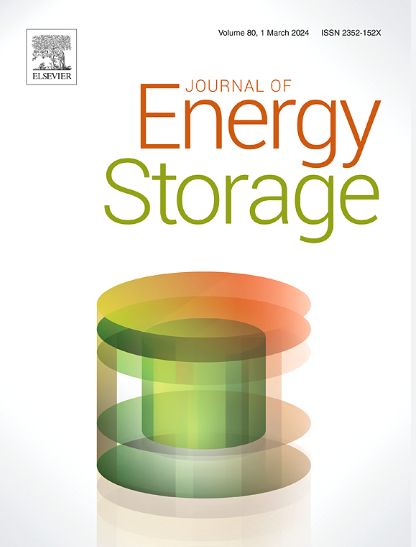Polyaniline nanowires anchored on MXene quantum dots/graphene composite fibers with 0D-1D-2D hierarchical structure for high-performance wearable supercapacitors
IF 8.9
2区 工程技术
Q1 ENERGY & FUELS
引用次数: 0
Abstract
Two-dimensional graphene and MXene are promising and attractive candidates as energy storage materials for wearable supercapacitors. However, low energy density derived from a serious restacking problem restricts their charge storage capacity and actual application for portable electronic devices. In this study, we report a microfluidic technique assisted wet spinning method for the fabrication of polyaniline nanowires modified MXene quantum dots/graphene composite fibers (PANI@MQDs/GF) with 0–1-2 dimensional (0D-1D-2D) hierarchical structure. The effective combination of multicomponents, strong synergistic effect at the nanoscales and 0D-1D-2D hierarchical structure of PANI@MQDs/GFs not only alleviate the restacking of graphene nanosheets but also enhance interfacial charge transfer, more accessible sites and fast pathways for ion kinetic migration and accumulation, leading to excellent structural stability and electrochemical performance. Fiber-based flexible supercapacitors assembled by PANI@MQDs/GF exhibit a superior specific areal capacitance of 1691 mF cm−2 (for specific volumetric capacitance of 450 F cm−3), maintain a high capacitance retention of nearly 100 % after 9500 cycles, and achieve an excellent energy density of 214.4 μWh cm−2. The designed 0D-1D-2D hierarchical structure of composite fibers can also be extended to other lamellar materials, and exploit more possibilities of fiber-typed supercapacitors for portable/wearable electronics application.
0D-1D-2D分层结构MXene量子点/石墨烯复合纤维上的聚苯胺纳米线用于高性能可穿戴超级电容器
二维石墨烯和MXene作为可穿戴超级电容器的储能材料是很有前途和吸引力的候选材料。然而,严重的再堆叠问题导致的低能量密度限制了它们的电荷存储能力和在便携式电子设备中的实际应用。在这项研究中,我们报告了一种微流控技术辅助湿纺丝方法,用于制备具有0-1-2维(0D-1D-2D)层次结构的聚苯胺纳米线修饰MXene量子点/石墨烯复合纤维(PANI@MQDs/GF)。PANI@MQDs/GFs的多组分有效结合、纳米级强协同效应和0D-1D-2D层叠结构不仅减轻了石墨烯纳米片的再堆积,而且增强了界面电荷转移、更易于接近的位点和离子动力学迁移和积累的快速途径,从而获得了优异的结构稳定性和电化学性能。PANI@MQDs/GF组装的光纤柔性超级电容器具有1691 mF cm−2的比面积电容(比体积电容为450 F cm−3),在9500次循环后保持近100%的高电容保持率,并达到214.4 μWh cm−2的优异能量密度。所设计的复合纤维0D-1D-2D分层结构也可扩展到其他层状材料,为便携式/可穿戴电子产品开发更多光纤型超级电容器的可能性。
本文章由计算机程序翻译,如有差异,请以英文原文为准。
求助全文
约1分钟内获得全文
求助全文
来源期刊

Journal of energy storage
Energy-Renewable Energy, Sustainability and the Environment
CiteScore
11.80
自引率
24.50%
发文量
2262
审稿时长
69 days
期刊介绍:
Journal of energy storage focusses on all aspects of energy storage, in particular systems integration, electric grid integration, modelling and analysis, novel energy storage technologies, sizing and management strategies, business models for operation of storage systems and energy storage developments worldwide.
 求助内容:
求助内容: 应助结果提醒方式:
应助结果提醒方式:


